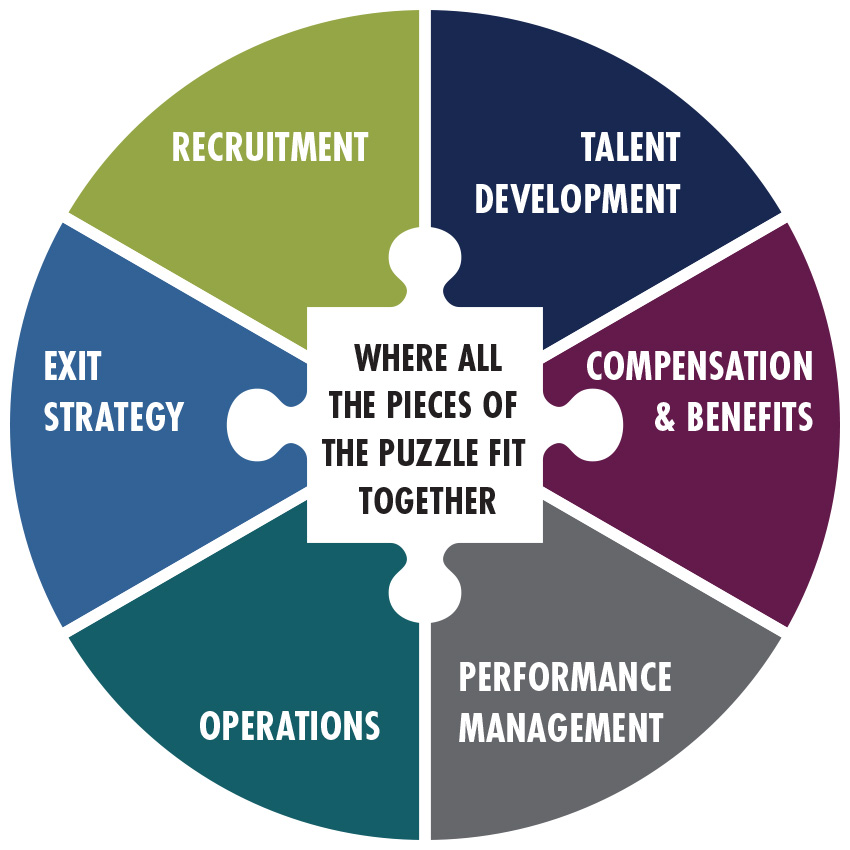You spend a lot of time building up your organization and perfecting your product. But what about your people? As a small business owner, staffing is vitally important, especially for organizations in growth mode. These are the people that keep you from working long(er) hours, help you scale and provide you with valuable feedback.
Often, human resources (HR) is overlooked, especially as you’re trying to wear multiple hats. But we’re here to tell you it’s an essential component of any organization and critically important to get right. Here are a few reasons why:
Where All of the Pieces of the HR Puzzle Fit Together

- Legal Issues
There’s a lot of legal stuff surrounding HR, and not just in the context of disciplinary action and termination. Legally protected discriminatory issues—such as race, age, citizenship status, disability or gender—can come up due to seemingly innocent or conversational questions. For instance, did you know you can’t ask an applicant what they enjoy doing in their spare time? And that is only the beginning. If an applicant feels they did not get the job because of such questions during the interview, they can legally pursue discrimination claims.
An employee handbook can act as the company's first line of defense against lawsuits or liability claims. It can protect both employers and employees. But maybe the thought of preparing a new employee handbook or the task of revising your current handbook overwhelms you. Watch the video below to learn the importance of creating an effective employee handbook and the topics that should be covered in the handbook. In addition, you will learn about the types of employment policies that are required by federal law and how those laws apply to employee handbooks.
Recorded Webinar: The Importance of an Employee Handbook
- Recruiting & Performance Management
All organizations strive to have happy, healthy employees. Most businesses have specialized professionals for finance, marketing and operations. In a small business, these roles may be taken on by one individual, and that may even be you. However, since the HR field is full of complexities, it’s important to have a knowledgeable HR professional or team.
An HR professional can strategize the hiring process from recruitment, interviewing, and onboarding. After an individual is hired, the HR professional is responsible for gauging and maintaining employee satisfaction. They can send out satisfaction surveys, meet with key team members and facilitate exit interviews, all of which will give you vital information and insight into the people on your team.
Why is this so key? In small organizations, people are often performing multiple duties, as well as carrying around a lot of knowledge about the way things are done. Think about what would happen if you lost just one key individual during the early stages of your business. How would that affect your bottom line?
Let’s not forget to consider the cost of training a new employee versus maintaining a good employee. It can cost anywhere between 30-50% of an employee’s salary to onboard a new employee. Those numbers can really add up.
It’s important to have a future-forward attitude, so you can resolve any issue that may arise and ultimately improve your business. When you’re just starting a company, you’re looking for anyone to help make your dream a reality. But what happens if, as your company expands and grows, you realize one particular employee isn’t in the right place within your organization? Do you have a plan to improve employee performance?
“Without a human resources staff person to construct a plan that measures performance, employees can wind up in jobs that aren’t sustainable for their skills and expertise,” according to the Houston Chronicle.
Here are a few ways you can utilize HR for hiring practices.
- Professional Procedures
We are all human beings, and sometimes we don’t get along with everyone else. Do you know who within your organization will handle workplace conflict? As ideal as it would be to say, “we’re all adults, figure it out,” it’s best to have a skilled professional available to handle employee relations and conflicts.
HR also plays an important role in mitigating the risk of sexual harassment and responding to sexual harassment claims, which will become more important as your company grows.
- What Is Sexual Harassment?
Before identifying how to handle sexual harassment in the workplace, it’s important to understand exactly what it is. Sexual harassment, as defined by the Equal Employment Opportunity Commission and Title VII of the Civil Rights Act, is “unwelcome sexual advances, requests for sexual favors and other verbal or physical harassment of a sexual nature.” What may or may not be known is that it can also include offensive remarks or offhand comments that happen often enough and are severe enough to make the workplace feel uncomfortable or “hostile.” And, harassment is in the eye of the beholder—not the in the intent of the person making the comment(s) or behaving in a manner that creates an uncomfortable work environment. With this in mind, employers and employees need to be careful with how they conduct themselves in the workplace. - Start with Proper Policy
The best approach to work environment harassment is to prevent it from happening in the first place. A good place to start is with a workplace policy. An appropriate policy will be written in terms that all employees can understand and will explain the process for reporting harassment, as well as the potential “punishment” for committing harassment. The policy can be part of an employee handbook or policy manual, and a signed acknowledgement form should be gathered from each employee to document the policy has been reviewed with them. A good time to review the policy and collect the acknowledgement form is during new hire training. If a company does not have a harassment policy, one should be created and communicated to all employees with the requirement that an acknowledgement form be signed and returned within a specific time frame. Acknowledgement forms should be retained in each employee’s personnel file. - Train Everyone Regularly
Once a policy is in place, training the workforce on how to prevent harassment is the next step. Media Partners, Kantola Training Solutions and Skillsoft are training companies that produce harassment prevention and awareness videos and provide several options for employers to choose from to ensure they select a training that best suits their workforce (be it professional services, construction, or something in-between). Harassment prevention training should be conducted as part of orientation with refresher training required every three to five years thereafter. A method for tracking when an employee has completed the training is recommended, and training records should be included in the employee’s personnel file. - Investigating Claims
If a company finds itself in the midst of a harassment claim, the best process to follow is one that is confidential with a prompt, thorough and impartial investigation. A human resources professional is typically the most appropriate person to conduct the investigation to gather facts from the individuals involved in the situation (including witnesses). Once the investigation is concluded, immediate and appropriate corrective action should be taken, which may include a warning for minor offenses or termination for gross misconduct. Whatever action is taken, it should be handled professionally and confidentially. Witnesses and/or the person bringing the claim forward may not be privy to the outcome details.
It is also important to understand that if an employee posts #metoo through social media, and that post is brought to the attention of someone within the company, the company will put itself at risk if it does not investigate it further.
- Training and Development
When an employee begins working with your company, they need some sort of training. HR helps to perform onboarding functions like training and review of benefits, and they can even be part of the interview process.
HR teams can also provide training and development opportunities to make sure current employees are able to improve on their skills and qualifications. By identifying areas for improvement, HR professionals can work to improve the skills of your current work force, saving you time and money in hiring and training new employees.
If an employee decides to leave, HR professionals can work to ensure they know the reasons why through an exit interview, and they can also assure that employees aren’t walking away with valuable knowledge which hasn’t been transferred.
The bottom line is that HR doesn’t only affect people within your organization, it affects your bottom line. It’s important to have systems in place, all the way from recruitment to exit, to ensure you’re not only compliant, but also employing good, quality people.
Although this may sound daunting, know that we can help you. Eide Bailly’s HR Consulting Services professionals are here to assist you with developing a recruitment process and tools for you to implement and/or finding that “difficult-to-find” individual who can make an impact on your team.
Does this seem like a lot of work?
We're Here to Help


